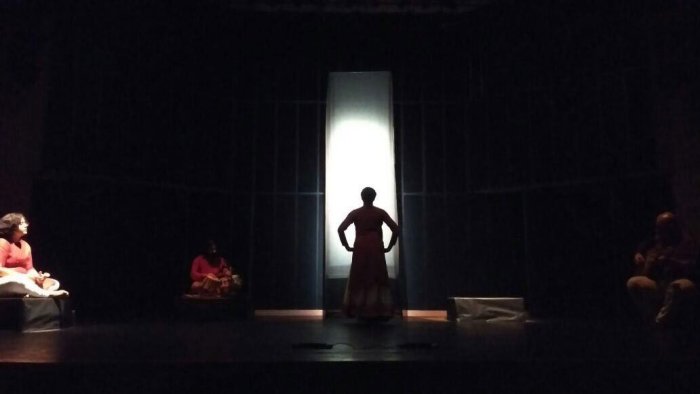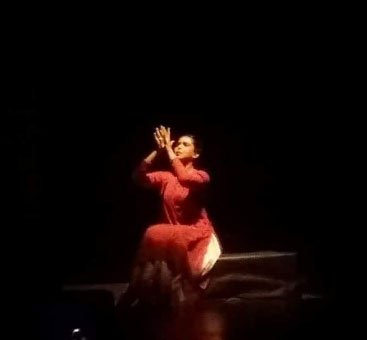
|   |

|   |
 e-mail: leelakaverivenkat@gmail.com Poetry in out-of-the-book art translations November 16, 2017 The vigour, gut involvement and passion of Beej, an interdisciplinary initiative based in Mumbai, offering creative verbal and non-verbal translations in an interactive multitude of art languages, of poetry exploring the inner voice which dares expression titled by Arundhathi Subramaniam ‘When God is a traveller,’ has to be experienced to be believed. Kathak dancer Sanjukta Wagh with her dance training under Rajashree Shirke and Hindustani music under Pandit Murli Manohar Shukla is with three other fellow travellers on this art journey - singer Shruthi Vishwanath trained in Carnatic music under Kala Acharya B. Krishnamoorthy and Komaanduri Seshadri among others, guitarist and composer Hitesh Dhutia and tablist Vinayak Netke - all creating magic in music, dance, theatre and rhythm, exploring select pieces of Bhakti poetry in a new persuasive blended art union full of conviction. The excellent lighting effects are provided by Deepa Dharmadhikari who studied lighting design at the University of Minnesota-Twin cities, while pursuing a BFA in Dance. As soon as Sruthi in her rich soprano voice started Kabir’s “Jeeni Jeeni” (A weave that dares to embrace air as contemporary poet Arundhathi Subramaniam said), the longing in that voice seeming to seep into the mysterious spaces of one’s heart and soul, you knew that this evening was going to be different from one of those innumerable art offerings.  Sitting in her workaday clothes, her singing (music is by Kumar Gandharva, Gundecha Brothers, Jitendra Abhisheki and Vishwanath herself) of Kabir’s poem, had the throb of the passionate inner person communicating with an individualistic flavour - the music in a wailing Charukesi giving one goose pimples. And if the music brought you the pulse of that loom creating the weave enmeshing the threads running up and down with those running sideways, the dancer’s slow hand movements gracefully moving up and down and sideways in an improvised manner, with footsteps appearing slowly, gradually expanding in intricacy and speed seemed to weave in the metaphor of life itself with its polarities, with the added pulse of the tabla, and the interventions on the guitar. With finger tips of the dancer seeming to engage in a soft interaction, the hand gathers in a kapotha mudra, a salutation. Bheegi chadariyan, the wet weave (and dancing with a chadar is so familiar to Kathakars) and with the speed of the charka dhole, one sees the weaving of creation itself with animals, birds and flowers which grow old and fade away. The weave (chadar), which sages wear and drape round their figures, is the same which becomes the shroud for man when he bids goodbye and is laid to rest. That chadar is all he needs. It is with a great deal of symbolism woven into the short piece with nirgun and sagun playing hide and seek, rendered with an involvement wherein all the languages of dance, music, instruments came together in a weave that entwines the viewer’s heart.  The next poem belonged to Sant Janabai of Maharashtra, who from the devalued status of a domestic servant declares her love for Siva, knowing no half measures. “I erupt from pillars; I am half woman half lion; I am your whore Keshava, come to wreck your reputation.” In fast dancing, in a devil may care attitude, Janabai who discards clothes and every ornament on her, stands offering herself to Shiva, daring him to come and take her. Sanjukta, in total abandon, half-seated in a broad chauka (bye bye to Kathak) throwing her hands as if to say ‘Come and take me’ became the soul of unselfconscious ardour.  The next poem by Ambigara Chowdaiyya, an untouchable whose Kannada sahitya says: “Kerenile illada Mahanadiyali odalillada ambike bandidini.” She urges the fairy man without a body to take her across to the ‘village without words’. She has no fear now as she says: “Naiya morire, Lagi lagire mori…. Aandi megha kachu kachu na lage dar kachu nahi.” With a foot twirling, she plays with the water. Throwing away all cares, she leaves it to Him to look after her and enable her to cross the river of life. The main thrust in every poem was the strong take-off provided by the music, lilt, melody, conviction and soaring voice, providing all the participants with an excellent aural/emotive backdrop. Here was abstraction in full throttle. The last poem by Tukaram shows the devotee through agonisingly difficult tasks he has to deal with, like a catastrophe so enormous that it leaves even language stripped naked, robbing the entire world of eloquence. One knows then that God is visiting you. Panduranga is Chokhamela’s sakha and with such a friend even when robbed of a drop of water to slake one’s intense thirst, he cries out to Panduranga and licks his fingers and suddenly drops of water followed by a flow starts and to the ecstasy of Vithala, Vithala, carrying the entire audience to a different space, when the programme ended, the uninterrupted applause conveyed the warm thanksgiving for an unusual programme. Very gratifying to see real manodharma in action!  Writing on the dance scene for the last forty years, Leela Venkataraman's incisive comments on performances of all dance forms, participation in dance discussions both in India and abroad, and as a regular contributor to Hindu Friday Review, journals like Sruti and Nartanam, makes her voice respected for its balanced critiquing. She is the author of several books like Indian Classical dance: Tradition in Transition, Classical Dance in India and Indian Classical dance: The Renaissance and Beyond. Post your comments Please provide your name and email id when you use the Anonymous profile in the blog to post a comment. All appropriate comments posted with name & email id in the blog will also be featured in the site. |